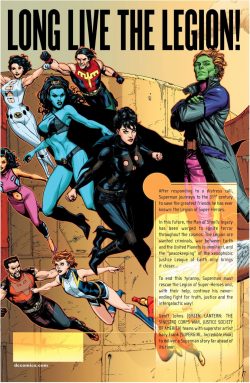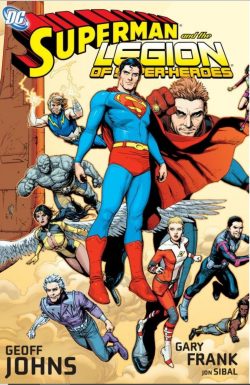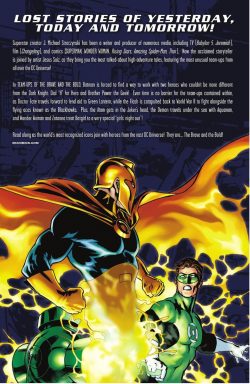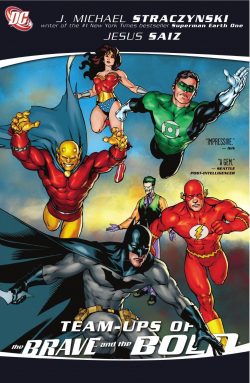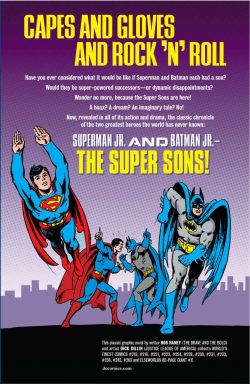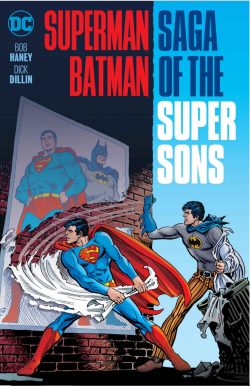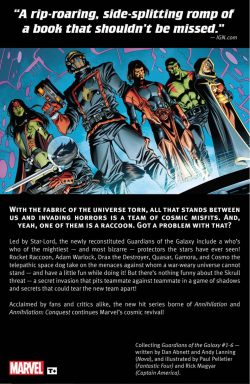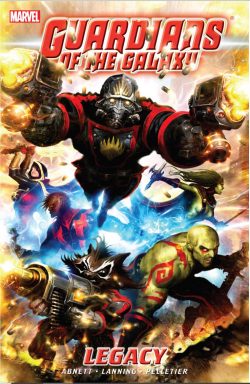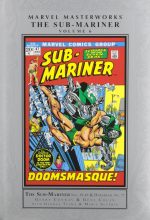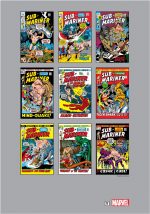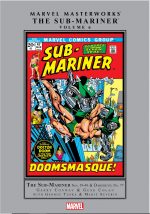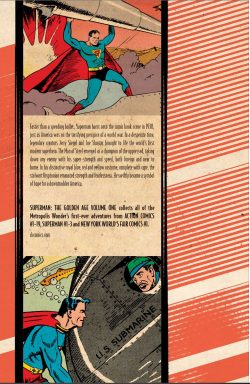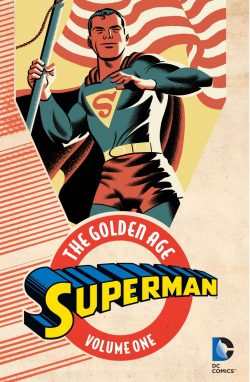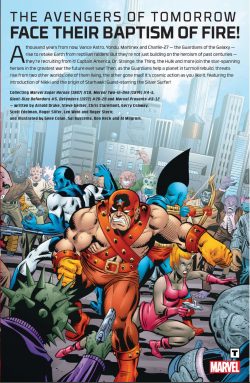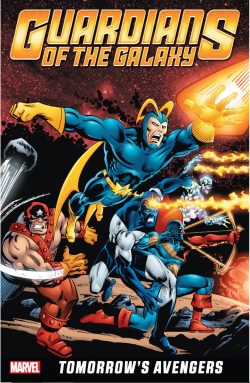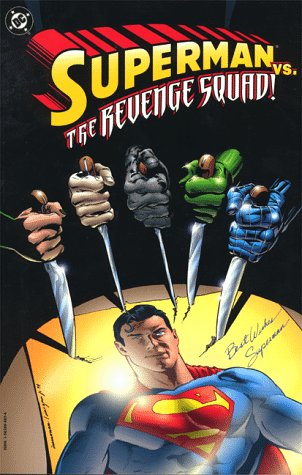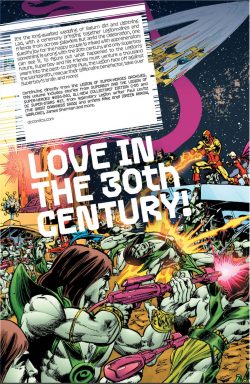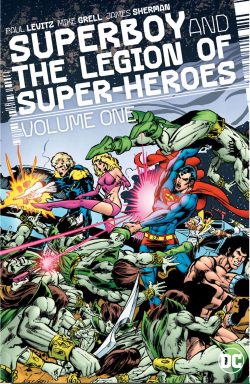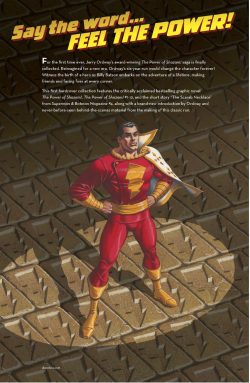
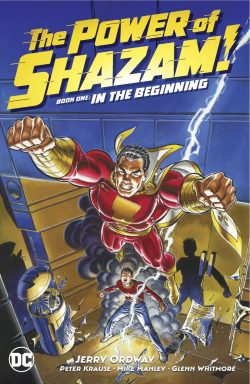
By Jerry Ordway, Peter Krause, Mike Manley, Curt Swan, Mike Parobeck, Rick Burchett, Kurt Schaffenberger, Glenn Whitmore& various (DC Comics)
ISBN: 978-1-4012-9941-5 (HB/Digital edition)
Superman debuted in Action Comics #1 in the summer of 1938. Created by Jerry Siegel & Joe Shuster, the character proved extremely popular across many disparate media, sparking a new kind of hero and story form. You’re here right now because of him…
Another of the most venerated and loved characters in American comics was created by Bill Parker & Charles Clarence Beck for Fawcett Publications as part of a wave of opportunistic creativity that followed that successful launch of Superman. However, although there were many similarities in the early years, the “Big Red Cheese” moved swiftly and solidly into the arena of light entertainment and even broad comedy, whilst – as the 1940s progressed – the Man of Tomorrow increasingly left whimsy behind in favour of action and drama.
At the height of his popularity, Captain Marvel hugely outsold Superman but, as the decade progressed and tastes changed, sales slowed. When an infamous copyright infringement suit filed in 1941 by National Comics was settled the Captain and his crew – like so many other superheroes – disappeared to become fond memories for older fans.
A syndication success, he was missed all over the world. In Britain, where a reprint line had run for many years, creator/publisher Mick Anglo had an avid audience and no product, so transformed Captain Marvel into atomic agent Marvelman, continuing to thrill readers into the 1960s.
Decades later, American comics experienced another superhero boom-&-bust, and the 1970s dawned with a shrinking industry and wide variety of comics genres servicing a base that was increasingly dependent on collectors and fans rather than casual or impulse buyers. National Periodicals/DC Comics needed sales and were prepared to look for them in unusual places.
Since the court settlement with Fawcett in 1953, they had pursued the rights to Captain Marvel and his spin-offs. Now, though the name itself had been claimed by Marvel Comics (via a quirky robot character published by Carl Burgos and M.F. Publications in 1967), the publishing monolith opted to tap into that discriminating if aging fanbase.
In 1973, riding a wave of national nostalgia on TV and movies, DC brought back the entire beloved cast of the Original Captain Marvel crew in their own kinder, weirder universe. To circumvent the intellectual property clash, they named the new title Shazam! (…With One Magic Word…) referencing the memorable trigger phrase used by myriad Formerly Fawcett-Marvels to transform to and from mortal form… a word that had entered the idiom and language due to the success of the franchise the first time around.
He’s been a star in DC’s firmament ever since, but one who’s endured much rejigging, refurbishment and narrative refinement, even if the fundamentals have never varied…
Homeless orphan and thoroughly good kid Billy Batson was selected by an ancient wizard to battle injustice with the powers of six gods/legendary heroes. By speaking aloud the wizard’s name – itself an acronym for the six patrons Solomon, Hercules, Atlas, Zeus, Achilles and Mercury – Billy would transform from scrawny boy to brawny (adult) warrior Captain Marvel: dispensing justice and mercy with the forgiving grace of an innocent child…
There have been many enjoyable, effective and fittingly contemporary treatments, but perhaps the very best was one fully embracing the original tone: successfully recapturing the exuberance and charm – albeit layered with a potent veneer of modern menace.
It began with Jerry Ordway’s 1994 re-imagining in an Original Graphic Novel: based as much on the 1941 movie serial as the forceful yet fun comics of Bill Parker, Otto Binder, C.C. Beck, Joe Simon, Jack Kirby, Pete Costanza and their cohort of creative colleagues…
That groundbreaking yarn and the series it spawned became a thriving, vibrant cornerstone of DC Continuity. This reprint edition combines the OGN and first dozen issues (cover-dated March 1995-February 1996) of that series, each with a lovely painted Ordway cover. Adding to the appeal is a short but sweet contemporary treat from young readers title Superman & Batman Magazine #4, a new Introduction from Ordway and a swathe of extras at the end…
With Ordway doing everything but the lettering (that’s courtesy of John Costanza) the epic reboot opens in Egypt, where archaeologists Charles “CC” Batson and his wife Marilyn lead the prestigious Sivana Expedition in a search for knowledge and antiquities.
That doesn’t precisely fit with orders given to the sponsor’s ruthless representative Theo Adam, who has his own instructions regarding certain treasures. When the Batsons uncover the lost tomb of unknown dignitary “Shazam”, tensions boil over and murder occurs.
The historians had left their son in America with Charles’ brother, but taken their toddler Mary with them. After the bloodshed ends, both she and Adam have vanished without trace.
Some years later Billy Batson is a little boy living on the streets of ultra-modern art deco Fawcett City. His parents had left him with CC’s brother Ebenezer when they went away. When they never returned, the boy was thrown out as his uncle stole his inheritance. No one knows where Billy’s little sister is…
Sleeping in a storm drain, selling newspapers for cash, the indomitable kid is pretty street-savvy, but when a mysterious shadowy stranger who seems comfortingly familiar bids him follow into an eerie subway, Billy just somehow knows it’s okay to comply.
When he meets the wizard Shazam and gains the powers of the ancient Gods and Heroes he knows he has the opportunity to make things right at last. However, he has no conception of the depths evil corporate vulture Thaddeus Sivana can sink to, nor the role mystical exile Black Adam played in the fate of his parents…
Newly empowered by the wizard, Billy turns his life around, adapts to life as an underage superhero and spectacularly brings both murdering Theo Adam and his maniacal boss Sivana to justice whilst defeating his own wicked predecessor, before setting out to confront even greater challenges like finding his lost sister…
This superb and mesmerising retelling led to the most successful comic book revival Captain Marvel has yet experienced. Characters refitted there are potently realistic but the stories offer a young voice and sensibility. Moreover, the pulp adventure atmosphere conjured up by Ordway in conjunction with his sumptuous painted art and spectacular design make for a captivating experience, and his writing has never been more approachable and beguiling.
The author – with penciller Peter Krause & inker Mike Manley – would build on the tale in the series that followed: employing a cunning long-term scheme to adapt classic Golden Age tales to modern tastes under a slick veneer of retro fashion.
Before that though, Ordway, artists Parobeck & Rick Burchett, colourist Glenn Whitmore & Constanza delivered a smart vignette in Superman & Batman Magazine #4. Aimed at introducing the DCU to early readers, the comic saw Billy stumble into a museum robbery by an old enemy before saving ‘The Scarab Necklace’…
Ordway, Krause & Manley then began the long haul – in its own rather staid and timeless corner of the DCU – with The Power of Shazam! #1 as ‘Things Change’. Billy now has a job as an announcer/roving reporter for WHIZ radio and an apartment. He lives there alone, using his alter ego as his live-in “responsible adult” Uncle Eben. Billy has been sporadically mentored by the wizard who has also been fruitlessly seeking Billy’s vanished sister…
Captain Marvel has established himself as the champion of Fawcett City: defeating countless crooks, monsters and even the occasional supervillain.
A new chapter begins when one of them – IBAC – literally crashes the launch of a new Wayne-Tech facility sponsored by property speculator Sinclair Batson. The shallow sleazeball is apparently the son and heir of the real Ebeneezer Batson, but neither Billy or anyone else has ever heard of him…
Late for school again, the cousins unknowingly “meet” when the Big Red Cheese pulls Sinclair out of the skyscraper’s razed rubble. Always ready to schmooze, the speculator “rewards” the hero with an invitation to his next high society soiree…
Elsewhere, concerned school custodian Dudley H. Dudley has deduced Billy lives alone. He tries to help the scrappy little guy, interceding whenever head teacher Miss Wormwood targets the lad for “special attention”. Billy is baffled but grateful, yet has bigger problems, like IBAC and a scheming female racketeer with a hidden agenda and unknown powers…
Never one to miss a free meal, Billy attends the party as his older self: taking the opportunity to assess just what he’s missing in the mansion he grew up in and which should by rights be his. It’s an uncomfortable experience. When not fending off distant relatives who all recognise him somehow (Marvel is the spitting image of dead CC Batson) he’s being not-so-subtly hit on by ultraglamorous vamp Beautia Sivana. Thus it’s actually a relief when the wizard summons him to the Rock of Eternity to chastise him for misusing his abilities…
The confrontation is acrimonious and ends with Billy being stripped of his gifts and sent back to Earth… just as the Batson mansion goes up in flames, trapping everyone inside!
A vision of Hell ruled by demon queen Lady Blaze briefly paralyses the boy before Billy finds a way to get all the rich folk out, but in the aftermath the juvenile journalist pokes around and discovers a connection between embezzling Ebeneezer and mystic pyromaniac ‘The Arson Fiend’. Thankfully, Shazam is monitoring, and returns Billy’s powers when the flaming fury goes after the boy…
IBAC returns in TPoS! #3 as the Captain saves undercover cop Muscles McGinnis, before ‘Lost and Found!’ sees the lost sister subplot advanced by the introduction of rich Mary Bromfield. She’s a competitor in a Spelling Bee compered by Billy for WHIZ – as is perfect jock Freddy Freeman: another kid who will have a momentous impact on Batson’s life…
When adopted Mary and her devoted nanny Sarah Primm are kidnapped, super-thug IBAC again battles our hero, and the wizard realises the child he’s been searching for was under his nose all along. Moreover, if he couldn’t see her, who or what has been frustrating his efforts?
In ‘Family Values’ a staged fight between Cap and McGinnis magnifies the secret cop’s underworld standing whilst covertly providing proof of Mary’s identity. Billy then has a chat with her favourite doll as stuffed toy Mr. Tawky Tawny comes to life and joins the cast. By now, the boy takes weird happenings in his stride, but is still rattled enough to inadvertently reveal his secret identity to “Uncle Dudley”. Billy assumes the tiger’s animation was Shazam’s doing, but he couldn’t be more wrong…
When Tawky Tawny manifests to Mary, his urgings result in her saying “Shazam!” and transforming into an adult superhero in time to thrash the returned kidnappers. Tragically it’s not enough to save Nanny Primm, whose deathbed confession reveals her as Theo Adam’s sister, as well as her part in getting baby Mary back to the USA after the Batsons died…
Enraged and vengeful “Mary Marvel” goes after Adam – struck dumb by the wizard ever since he was briefly possessed by Black Adam – before regaining her composure. She then stumbles into a riot sparked by a mind-bending neo-Nazi as ‘Madame Libertine Strikes!’
In Hell, guilt-wracked Sarah Primm is being tortured by upstart Lady Blaze as part of a byzantine plot to rule all, which also includes Libertine. Escaping the justifiably angry superwoman, the racist killer returns to her grandfather’s laboratory just as he cracks open a suspended animation capsule that has kept a WWII terror alive for half a century…
As Billy and Mary are summoned to the Rock of Eternity to learn that the gifts of the gods are finite and when both use them at once their power halves, Fawcett City trembles at ‘The Return of Captain Nazi!’ As McGinnis meets the racket boss and accidentally gleans her horrific secret, the Aryan atrocity goes on a rampage. Clashing with Captain Marvel whilst robbing a bank, Nazi grievously injures Freddy Freeman and his grandfather, prompting Mary (who has a far more instinctive and effective grasp of the magic) to suggest that she and Billy further share it…
Freddy regains a modicum of health in ‘The Balance of Power’ as he also becomes a superhero: tapping into the Shazam force as Captain Marvel Junior, but his desire for revenge and rebellious nature make his a volatile ally at best…
Insight into the oddly timeless nature of Fawcett City comes in ‘After the Fall…’ (with additional art by Curt Swan) as Golden Age greats Bullet-Man, Minute-Man and Spy Smasher appear in a telling flashback detailing their last battle with Captain Nazi, and hinting at the Übermensch’s unfinished business today. The veteran heroes are still robust and spry in modern times and offer useful hints to reporter Billy, whose investigations mean he’s not around to stop the Aryan busting Theo Adam out of custody, or vengeance-mad Freddy going after them both. Worst of all with Mary powered up and soon joined by Captain Marvel, none of them are strong enough to stop the villains. With Blaze moving all her pawns into place, Captain Nazi finally completes his 50-year delayed mission, but learns that time is ruthless and unforgiving…
As the Marvels converge on the despondent fanatic and combine ‘…The Power of Shazam!’, Blaze strikes the Rock of Eternity, using a restored Black Adam to capture the wizard and drag him to Hell. For good measure, she also liberates humankind’s most pernicious spiritual predators and unleashes them to Earth…
Adam joins them there and – with the wizard gone – neither Mary nor Freddy can change back and surrender their portion of the power to Billy. The twisted nemesis savagely beats Captain Marvel: breaking limbs and leaving him near-death. As the Underworld Unleashed event impinges on these stories, Lady Blaze reveals her shocking connection to Shazam as ‘In the Beginning…’ (with additional art by Ordway) explores the origins of the wizard and all superheroes on Earth…
With the Demon Queen’s plans revealed and ultimate universal horror The Three Faces of Evil almost liberated, Tawny’s true nature is exposed, Earthbound Mary gathers allies for the final battle and the greatest sorcerer of all time is revived to join the fray…
With additional pencilling by Swan, ‘The Seven Deadly Enemies of Man’ pits a valiant team of veteran Fawcett champions against the infernal antagonists before charging off to face Blaze, with Black Adam’s pivotal power vacillating between destroying despised heroes and saving his sister Sarah from Hell…
With writer Ordway again joining Krause & Manley on illumination, it all thunders to a cataclysmic climax in ‘End Game’, as the heroes plunge into Hell, the truth about CC Batson and Fawcett City come to light and Shazam details the true extent of his manipulations of the city and its most valiant citizens. With order restored, the Marvels return just in time to expose the truth about Sinclair Batson and presage the appearance of possibly their greatest and most bizarre adversary…
A breathtaking joy from beginning to end, this superhero saga closes with those promised extras: a bevy of bonuses for everyone interested in how magic is made. These include author commentary, preliminary pencils and finished cover art for The Power of Shazam! OGN and trade paperback collection, the art deco-inspired retail poster and Ordway’s original story notes and preliminary pencils for TPoS! #8.
Much like the modern movie iteration, these comic classics triumph by remembering that fun is as important as thrills or action, and everything works best when three become one…
© 1994, 1995, 1996, 2020 DC Comics. All Rights Reserved.
